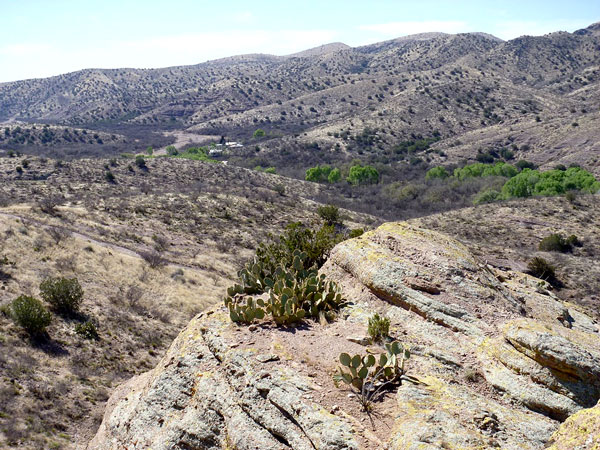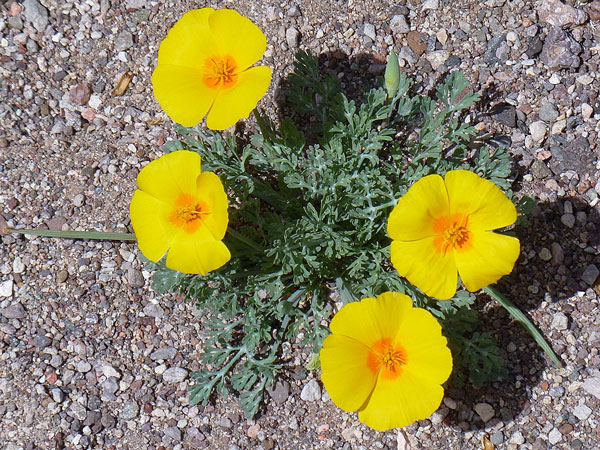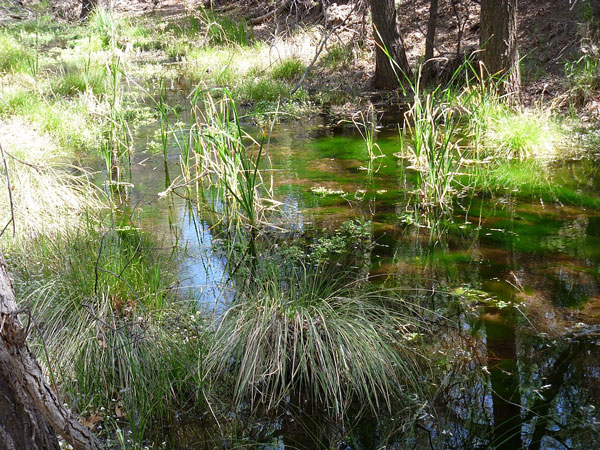Trip Leader and
Author:
Bill Priedhorsky
Participants: Melissa
Bartlett and Bill Priedhorsky
At this stage of
life, our adventures are not longer restricted to the wilderness,
but we still
seek out places that are at the
dead end of a long dirt road. After years of trying and at least one
cancelled reservation (family emergency), we finally visited the
Nature Conservancy’s Muleshoe Ranch. Our 4-night stay was over
spring break, at the beginning of April 2012. We were looking for
hiking, vistas, cool streams, and wildlife, with a comfortable place
to stay. We found it at Muleshoe.
Muleshoe is an
oasis amid arid grasslands. Riparian cottonwoods and sycamores start
at the ranch, where the Hooker Hot Springs flow into the eponymous
Hot Springs Wash. One arrives at headquarters from upstream, so the
vegetation around headquarters is the first greenery since Willcox,
30 miles away (19 of them graded dirt). Hot Springs Wash is just one
of seven flowing streams on the 49,000 acre Muleshoe Cooperative
Management Area, shared between the Conservancy, the Forest Service,
and BLM. We visited three streams in easy day hikes. Temperatures
were in the mid-70’s, only a little warmer than we would have liked.
When we return, we might target late November, when the days are
about 10° cooler.

Ranch headquarters
(white buildings) are along Hot Springs Wash,
just where the stream starts flowing thanks to the incoming springs.
We stayed in one
of the Conservancy casitas, which are remodeled from the original
ranch buildings. Our casita, the King, was the largest and entirely
comfortable with adobe walls, saltillo tile, and a full kitchen,
although the bathroom fixtures were turquoise holdovers from the
1960’s. Casita residents have access to a spacious common area, with
overstuffed leather chairs and couches. The view from inside the
common room and the deck out front was to the east, giving afternoon
shade and later a view of moon rise across the wash. Being an oasis,
the obligatory palm tree – one – marked the middle of the U-shaded
courtyard. Hummingbirds were a constant presence around at least 3
feeders, and orioles, cardinals, finches, white-crowned sparrows
flocked to sunflower seeds of their own. Signs warned us to keep
casita doors shut unless we wanted a rattlesnake as a bedmate. Our
casita cost $741 for the four nights.
No food is
available at the ranch so, forewarned, we stocked up at the Willcox
Safeway, a small-town supermarket with fewer choices than the Los
Alamos Smith’s but plenty to feed us for 4 days. Kitchen facilities
included a full-sized refrigerator and oven. A larger kitchen in the
common areas is available for $100 a day and is included without
charge for parties that rent all four courtyard casitas. A fifth
casita, separate from the others, is the only one that allows
children under 16. This restriction is lifted if the whole courtyard
compound is rented.
Muleshoe is at
the end of the graded road, as far as my Prius could take us. We
left it parked from the evening we arrived to the morning we left. A
sturdy four-wheel drive, however, could take you farther north into
Muleshoe, opening other possibilities for backcountry hiking. The
drive from Los Alamos is 500 miles, most of it interstate, requiring
about 8 hours behind the wheel plus stops.
The Muleshoe
stretch near headquarters is sere grassland, with the usual thorny
things – prickly pear, barrel cactus, ocotillos, spiny bushes. It
lies just at the edge of the saguaro country, with perhaps the
easternmost saguaro in Arizona a mile from our casita. The rock is a
volcanic conglomerate, which sticks out in peaks that look taller
than they actually are. The elevations around headquarters ranged
for 4000 feet at the stream to 5000 feet atop the crags. The thorny
things are spaced far enough apart to allow cross-country hiking
with care. A few flowers were blooming this somewhat dry spring,
particularly patches of white, yellow, and orange poppies.

Spring desert flowers
come with the rain. In wet years the hillsides
are covered with gold; in this drier spring, we saw some beautiful
little patches.
We hiked both
developed trails that depart from headquarters. The 3.5-mile Bass
Creek – Hot Springs loop is the must-do of the area, and was
featured as the April 2012
hike-of-the-month in Arizona Highways online. The loop starts
with a mile up and down the northbound road, crossing a ridge, then
turns down Bass Canyon, which flows perennially in most stretches,
to the confluence. The streamside is a striking contrast to the
desert a few yards away. Downstream hiking is a thrash if you leave
the trail, thanks to the thickness of the vegetation. Pools were
filled with native Arizona fish, although the only desert pupfish
that we saw were in a pond back at the ranch. The final mile up Hot
Springs wash alternated between dry gravel and a pleasant trickle,
in the shade most of the way thanks to overarching trees.

Flowing water in the
desert, like this stream in Double R Canyon,
is a special thing about Muleshoe.